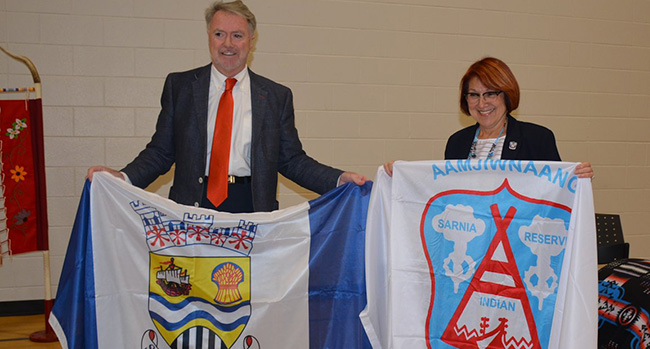Aamjiwnaang helps Sarnia select a new police chief

By Colin Graf
AAMJIWNAANG FIRST NATION – This community has found a unique way to promote good relations with its neighbouring city government in Sarnia by helping to select the city’s new police chief. In a process described as unique in Ontario, Chief Joanne Rogers consulted with Sarnia mayor Mike Bradley on the choice of a new head and deputy for the local police service, which also serves Aamjiwnaang.
“It was great to be involved in the selection process, and helped continue a good relationship between city police and the First Nation,” said Rogers. While not directly involved in the job interviews, Rogers says she was approached by the mayor to help with the hiring, and looked through the list of candidates being interviewed to offer her comments and suggestions. Her past career as a Justice of the Peace in Sarnia gave Rogers particular insight, she said.
Bradley invited her after an Aamjiwnaang citizen suggested the idea to him. There is a “direct linkage”, he says, as the community and city are in the process of negotiating a new policing contract. Rogers’ thoughts and opinions on the candidates “mirrored” those put forward by the police association, the body representing rank-and-file officers, said Bradley. Involving the police association in the selection process was also a ground-breaking step which appears to be unique in Ontario, he added.
Sarnia’s new police chief will be Insp. Norm Hansen, a 33-year member of the service, while the deputy will be Insp. Owen Lockhart, a 28-year veteran with the local police. They will take up their new positions in May and June when the current chief and deputy retire.
Rogers’ involvement is also part of a larger process of cementing good relations, Bradley said. During interviews with six or seven candidates for the lead positions in the police service, a specific question was asked of each about their relationship with Aamjiwnaang.
The First Nation’s chief and the police association will also be consulted during the yearly job review for the two officers. “This won’t be a one-off. They will give their input every year on how the relationship is working. That will be a really good way to keep leadership people sensitive to their role,” Bradley explained.
As far as Bradley, mayor for almost 30 years, knows, this system has not been used anywhere else in Ontario, but he hopes it will be adopted by other localities.
Relations between the police and First Nation are good, says Rogers, citing the quick response from police in Sept. 2016 in breaking up a marijuana grow-op in a wooded area of Aamjiwnaang as an example.
Police searched the area after a community member walking in the woods reported he was confronted by two Asian men carrying machetes, who demanded to know why he was there. Aamjiwnaang Council held an emergency meeting, and “we didn’t hesitate to ask police for assistance,” Rogers recalls. Officers were on the case the next day.
Sarnia police arrested two men when they found plots of land in the middle of the bush with a large number of plants, marijuana in various stages of production, and a hut with electrical power. The men, from Jarvis, ON, and London, ON were arrested and charged with possession and drug trafficking.
About 800 plants and 80 pounds of marijuana were seized with a street value, police said, of more than $1.1 million. Van Tung Tran, 60, of London, later pleaded guilty to producing marijuana, and was sentenced to two years in jail.
Mayor Bradley says another step being taken to build trust with Aamjiwnaang is advocating to have a First Nations person appointed to the Sarnia police services board. The board has been waiting for a new member, and Bradley hopes the new appointment will be announced soon by the province. Having a First Nations’ person on the police board would “fit well” with new provincial legislation that seeks to diversify police board membership.
The Liberal government introduced the Safer Ontario Act last fall, describing it as the largest policing and public safety transformation in a generation. The changes would modernize the approach to community safety, and improve police oversight and accountability, according to a provincial news release.
Ontario’s Attorney-General and Minister of Correctional Services have said the bill will also “ensure First Nations receive culturally responsive, sustainable, accountable, and equitable policing that has the flexibility to address specific community needs on their own terms.”
It’s important for the city and First Nation to work at building good relations on a regular basis, says Bradley, recalling when police worked with Aamjiwnaang leadership in 2012-13 to help negotiate an end to the blockade of a local rail line by First Nations protesters. “You can’t just communicate when there’s a crisis or a misunderstanding,” Bradley says.
City Council shows “much more recognition of how important the relationship is” with Aamjiwnaang today compared to the past, according to Bradley. The community’s involvement in the police chief hiring shows “we’re not just going to come to you on ceremonial issues – this is real.”


